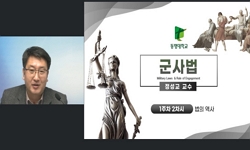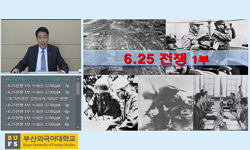The purpose of this study is to examine and analyze the Implementation of the Military Administration in North Korea during the Korean War. Before the final settlement on the issue of the military administration in the North Korean area between the RO...
http://chineseinput.net/에서 pinyin(병음)방식으로 중국어를 변환할 수 있습니다.
변환된 중국어를 복사하여 사용하시면 됩니다.
- 中文 을 입력하시려면 zhongwen을 입력하시고 space를누르시면됩니다.
- 北京 을 입력하시려면 beijing을 입력하시고 space를 누르시면 됩니다.

남한과 유엔의 북한지역 점령정책 구상과 통치 ― 타협과 현실의 괴리 ― = UN and the ROK’s Military Administration in the Occupied Area of North Korea, 1950
한글로보기부가정보
다국어 초록 (Multilingual Abstract)
The purpose of this study is to examine and analyze the Implementation of the Military Administration in North Korea during the Korean War. Before the final settlement on the issue of the military administration in the North Korean area between the ROK government and the UN, the occupied area was extended, and both the ROK government and the UN independently pursued military administration. In early October, the ROK Government detached its police order. From the beginning, the military administration in North Korea was carried out differently in the eastern and western areas in terms of system and operational procedure.
In the western area, dual systems of military administration were maintained by both sides as the US and the ROK forces occupied the important areas including P’yongyang; in the eastern area, the ROK forces took the initiative in the military administration as they advance across the 38th Parallel on October 1 and occupied the critical areas in advance while the UN forces landed in and occupied Hamkyong Province about one month later. The ROK forces thus proclaimed martial law in the northern part of Korea and set up a civil affairs bureau of martial law enforcement forces and appointed the chief of the bureau in each province.
The friction and confrontation in the process of starting the military administration between the ROK and the UN forces was submerged since the ROK government accepted the “October 12 Resolution” of the UN and thus recognized the UN sovereignty over the occupied area. Thus, the ROK government ceased its activities to lead the military administration, and those self-ruling committees, self-defense forces, and the police organizations were absorbed by authorities of the US military administration under its command. As the institutions for the UN military administration were organized in the P’yongannam-do area, a part of those police forces and administrative personal were incorporated into the organ of the UN administration, but the rest returned to the south.
Finally, the basic nature of the UN military administration in maintaining the self-rule under its command turned out to be a formality. However, the basis of the residents’ daily life depended upon the self-ruling committees, police, self-defense forces or security guard composed of the mature youth organized for each unit. Situations varied according to the region, but various social organizations, such as the YMCA, the Korea Youth Association, the Northwest Youth Association, and others were set up for active participation in the occupied area.
다국어 초록 (Multilingual Abstract)
The purpose of this study is to examine and analyze the Implementation of the Military Administration in North Korea during the Korean War. Before the final settlement on the issue of the military administration in the North Korean area between the RO...
The purpose of this study is to examine and analyze the Implementation of the Military Administration in North Korea during the Korean War. Before the final settlement on the issue of the military administration in the North Korean area between the ROK government and the UN, the occupied area was extended, and both the ROK government and the UN independently pursued military administration. In early October, the ROK Government detached its police order. From the beginning, the military administration in North Korea was carried out differently in the eastern and western areas in terms of system and operational procedure.
In the western area, dual systems of military administration were maintained by both sides as the US and the ROK forces occupied the important areas including P’yongyang; in the eastern area, the ROK forces took the initiative in the military administration as they advance across the 38th Parallel on October 1 and occupied the critical areas in advance while the UN forces landed in and occupied Hamkyong Province about one month later. The ROK forces thus proclaimed martial law in the northern part of Korea and set up a civil affairs bureau of martial law enforcement forces and appointed the chief of the bureau in each province.
The friction and confrontation in the process of starting the military administration between the ROK and the UN forces was submerged since the ROK government accepted the “October 12 Resolution” of the UN and thus recognized the UN sovereignty over the occupied area. Thus, the ROK government ceased its activities to lead the military administration, and those self-ruling committees, self-defense forces, and the police organizations were absorbed by authorities of the US military administration under its command. As the institutions for the UN military administration were organized in the P’yongannam-do area, a part of those police forces and administrative personal were incorporated into the organ of the UN administration, but the rest returned to the south.
Finally, the basic nature of the UN military administration in maintaining the self-rule under its command turned out to be a formality. However, the basis of the residents’ daily life depended upon the self-ruling committees, police, self-defense forces or security guard composed of the mature youth organized for each unit. Situations varied according to the region, but various social organizations, such as the YMCA, the Korea Youth Association, the Northwest Youth Association, and others were set up for active participation in the occupied area.
참고문헌 (Reference)
1 온만금, "한국전쟁시 한국과 유엔의 북한 점령정책" 7 : 1992
2 서용선, "한국전쟁시 북한 점령정책, In 한국전쟁 점령, 노무운용, 동원" 국방군사연구소 1995
3 육군 군사연구소, "한국전쟁사료: 육본 전투명령" 육군본부 1995
4 한모니까, "한국전쟁 전후 '수복지구'의 체제 변동 과정 : 강원도 인제군을 중심으로" 가톨릭대학교 대학원 2009
5 국방부 정훈국, "한국전란 1년지"
6 한모니까, "특집 : 한국전쟁기 미국의 북한 점령정책과 통치권 문제-평양과 양양 지역의 행정조직 구성 비교-" 한국역사연구회 78 (78): 161-193, 2010
7 "조선일보"
8 육군본부, "작전명령철(1950.7.25-12.20, HO00202)"
9 "유원식·이선근·정일권·백선엽 등의 증언록"
10 "서울신문"
1 온만금, "한국전쟁시 한국과 유엔의 북한 점령정책" 7 : 1992
2 서용선, "한국전쟁시 북한 점령정책, In 한국전쟁 점령, 노무운용, 동원" 국방군사연구소 1995
3 육군 군사연구소, "한국전쟁사료: 육본 전투명령" 육군본부 1995
4 한모니까, "한국전쟁 전후 '수복지구'의 체제 변동 과정 : 강원도 인제군을 중심으로" 가톨릭대학교 대학원 2009
5 국방부 정훈국, "한국전란 1년지"
6 한모니까, "특집 : 한국전쟁기 미국의 북한 점령정책과 통치권 문제-평양과 양양 지역의 행정조직 구성 비교-" 한국역사연구회 78 (78): 161-193, 2010
7 "조선일보"
8 육군본부, "작전명령철(1950.7.25-12.20, HO00202)"
9 "유원식·이선근·정일권·백선엽 등의 증언록"
10 "서울신문"
11 라종일, "북한통치의 반성: 1950년 가을, In 탈냉전시대 한국전쟁 재조명" 한국전쟁학회 1998
12 나종남, "북한지역 점령정책에 대한 평가: 한국과 미국의 갈등관계를 중심으로" 화랑대연구소 56 (56): 2000
13 박명림, "북한의 붕괴와 남한의 통치, 1950년 가을, In 한국 1950: 전쟁과 평화" 나남 2002
14 중앙일보사, "민족의 증언 3" 을유문화사 1972
15 "동아일보"
16 대한민국 국회, "국회속기록 제8회 42차"
17 Thomas S, "Teraji in FEC History Section, Korean Conflict : A Collection of Historical Manuscripts on the Korean Campaign, History of the Korean War, VolumeⅢ(Civil Affairs, Civil Assistance Problems), 1952, MF48(MF는 군사편찬연구소 마이크로 필름 번호)"
18 Chough Pyung Ok, "Home Minister to the UNCURK(4 Dec 1950). ROK Proposals to UNCURK regarding Unification(11 Dec 1950), A Supplementary Memorandum on the Same Subject Transmitted in Writing(11 Dec 1950), Seoul to Department of State, Dec 14, 1950, 357.AD/12-1450, SN.1457(SN은 군사편찬연구소 자료목록 번호)"
19 "Department of State, Internal Affairs(1950.10-12); Civil Affsirs Directives(Telegrams& Memorandum), 1950-1954, RG 59, Central Files Decimal File 795A series(1950-1954)"
20 "Department of State, FRUS, 1950, Vol.7."
21 김명기, "50년 북한점령지역에 대한 미국의 안정정책" 한국군사학회 14 : 1998
동일학술지(권/호) 다른 논문
-
한국전쟁기 북한의 점령과 지방사회의 변화 ― 경기도 시흥군의 사례 ―
- 한국근현대사학회
- 정병준
- 2012
- KCI등재
-
한국전쟁 이후 ‘收復地區’에서의 농지개혁법 적용 과정과 그 의미
- 한국근현대사학회
- 한모니까
- 2012
- KCI등재
-
- 한국근현대사학회
- 김보영
- 2012
- KCI등재
-
- 한국근현대사학회
- 기광서
- 2012
- KCI등재
분석정보
인용정보 인용지수 설명보기
학술지 이력
| 연월일 | 이력구분 | 이력상세 | 등재구분 |
|---|---|---|---|
| 2026 | 평가예정 | 재인증평가 신청대상 (재인증) | |
| 2020-01-01 | 평가 | 등재학술지 유지 (재인증) |  |
| 2017-01-01 | 평가 | 등재학술지 유지 (계속평가) |  |
| 2013-01-01 | 평가 | 등재학술지 유지 (등재유지) |  |
| 2010-01-01 | 평가 | 등재학술지 유지 (등재유지) |  |
| 2008-01-01 | 평가 | 등재학술지 유지 (등재유지) |  |
| 2005-01-01 | 평가 | 등재학술지 선정 (등재후보2차) |  |
| 2004-01-01 | 평가 | 등재후보 1차 PASS (등재후보1차) |  |
| 2003-01-01 | 평가 | 등재후보학술지 선정 (신규평가) |  |
학술지 인용정보
| 기준연도 | WOS-KCI 통합IF(2년) | KCIF(2년) | KCIF(3년) |
|---|---|---|---|
| 2016 | 0.66 | 0.66 | 0.71 |
| KCIF(4년) | KCIF(5년) | 중심성지수(3년) | 즉시성지수 |
| 0.65 | 0.62 | 1.675 | 0.11 |




 ScienceON
ScienceON 스콜라
스콜라






